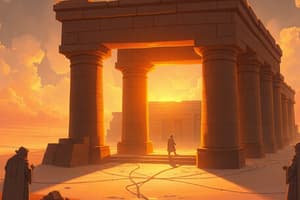Podcast
Questions and Answers
What was the lowest social class in Mesopotamia?
What was the lowest social class in Mesopotamia?
- Kings and Government Officials
- Slaves (correct)
- Priests
- Scribes
Who were responsible for creating laws in Mesopotamia?
Who were responsible for creating laws in Mesopotamia?
Kings and government officials
Scribes were required to be wealthy boys with no girls allowed.
Scribes were required to be wealthy boys with no girls allowed.
True (A)
Which social class was responsible for ensuring that people behaved in a way to please the gods?
Which social class was responsible for ensuring that people behaved in a way to please the gods?
What was the primary economic system used by traders, craftsmen, and merchants?
What was the primary economic system used by traders, craftsmen, and merchants?
What percentage of the population in Mesopotamia were farmers?
What percentage of the population in Mesopotamia were farmers?
The soldiers were in the same social class as the __________.
The soldiers were in the same social class as the __________.
Where did most merchants and traders live in relation to the ziggurat?
Where did most merchants and traders live in relation to the ziggurat?
Flashcards are hidden until you start studying
Study Notes
Social Classes in Mesopotamia
-
Slaves
- Lowest social class in Mesopotamia.
- Often consisted of prisoners or citizens who became slaves due to crimes or debt.
- Worked primarily for the upper class, including kings and priests.
-
Priests
- Occupied the highest position in the social hierarchy, acting as intermediaries between the gods and the people.
- Had exclusive access to ziggurats, sacred temples for worship.
- Responsible for ensuring societal conduct aligned with divine expectations.
-
Kings and Government Officials
- Held authority in law-making and governance.
- Typically resided near ziggurats in two-story homes, reflecting their status.
-
Soldiers
- Esteemed members of society, tasked with protecting the city-state.
- Shared social standing with scribes, who were vital for record-keeping.
-
Scribes
- Prestigious role requiring extensive education, specifically 12 years of training in cuneiform writing.
- Exclusively male and wealthy; poor individuals and females were excluded from this profession.
- Resided in one-story mud brick houses, positioned farther from the ziggurat than priests and kings.
-
Traders, Craftsmen, and Merchants
- Engaged in creating goods, selling merchandise, and trading with other city-states through a barter system.
- Lived the furthest from ziggurats in one-story mud brick houses, indicating their lower status compared to priests and officials.
-
Farmers
- Represented around 80% of the population, forming a significant part of the social structure.
- Worked in fertile fields producing crops such as barley, wheat, flax, onions, figs, grapes, and turnips.
- Shared their living conditions with traders and craftsmen in one-story mud brick houses.
Studying That Suits You
Use AI to generate personalized quizzes and flashcards to suit your learning preferences.




